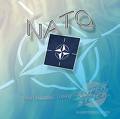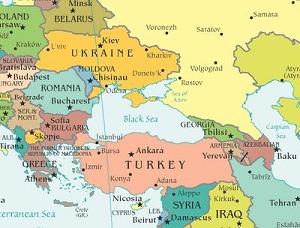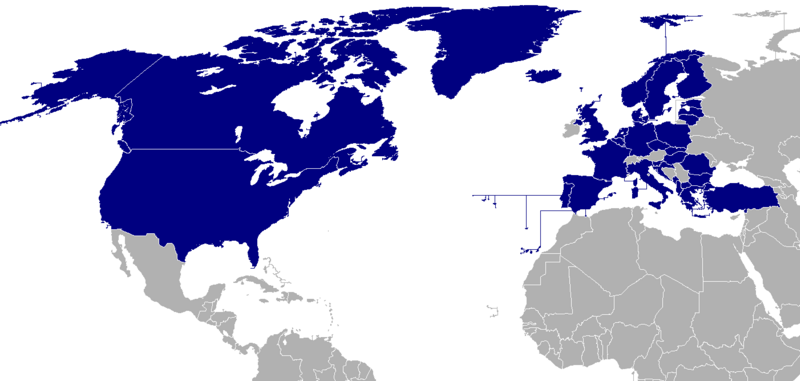Dangerous Crossroads: US-NATO To Deploy Ground Troops, Conduct Large Scale Naval Exercises against “Unnamed Enemy”

The World is at a dangerous Crossroads.
The Western military alliance is in an advanced state of readiness. And so is Russia.
Russia is heralded as the “Aggressor”. US-NATO military confrontation with Russia is contemplated.
Enabling legislation in the US Senate under “The Russian Aggression Prevention Act” (RAPA) has “set the US on a path towards direct military conflict with Russia in Ukraine.”
Any US-Russian war is likely to quickly escalate into a nuclear war, since neither the US nor Russia would be willing to admit defeat, both have many thousands of nuclear weapons ready for instant use, and both rely upon Counterforce military doctrine that tasks their military, in the event of war, to preemptively destroy the nuclear forces of the enemy. (See Steven Starr, Global Research, August 22, 2014)
The Russian Aggression Prevention Act (RAPA) is the culmination of more than twenty years of US-NATO war preparations, which consist in the military encirclement of both Russia and China:
From the moment the Soviet Union collapsed in 1991, the United States has relentlessly pursued a strategy of encircling Russia, just as it has with other perceived enemies like China and Iran. It has brought 12 countries in central Europe, all of them formerly allied with Moscow, into the NATO alliance. US military power is now directly on Russia’s borders. (Steven Kinzer, Boston Globe, March 3, 2014, emphasis added)

NATO’s top commander in Europe General Philip Breedlove (right) (AFP Photo / John Thys)
On July 24, in consultation with the Pentagon, NATO’s Europe commander General Philip Breedlove called for “stockpiling a base in Poland with enough weapons, ammunition and other supplies to support a rapid deployment of thousands of troops against Russia”.(RT, July 24, 2014). According to General Breedlove, NATO needs “pre-positioned supplies, pre-positioned capabilities and a basing area ready to rapidly accept follow-on forces”:
“He plans to recommend placing supplies — weapons, ammunition and ration packs — at the headquarters to enable a sudden influx of thousands of Nato troops” (Times, August 22, 2014, emphasis added)
Breedlove’s “Blitzkrieg scenario” is to be presented at NATO’s summit in Wales in early September, according to The London Times. It is a “copy and paste” text broadly consistent with the Russian Aggression Prevention Act (RAPA) which directs President Obama to:
“(1) implement a plan for increasing U.S. and NATO support for the armed forces of Poland, Estonia, Lithuania, and Latvia, and other NATO member-states; and
(2) direct the U.S. Permanent Representative to NATO to seek consideration for permanently basing NATO forces in such countries.” (S.2277 — 113th Congress (2013-2014))
More generally, a scenario of military escalation prevails with both sides involved in extensive war games.
In turn, the structure of US sponsored military alliances plays a crucial role in war planning. We are dealing with a formidable military force involving a global alliance of 28 NATO member states. In turn, the US as well as NATO have established beyond the “Atlantic Region” a network of bilateral military alliances with “partner” countries directed against Russia, China, Iran and North Korea.
Major US-NATO Naval Exercises
War preparations are invariably accompanied and preceded by major military exercises.
US-NATO multi-warfare naval exercises are to be conducted off the Florida coastline under operation FLEETEX, with the participation of the US, Canada, Germany and Turkey.
The underlying premise of these war games is “global warfare”. All four NATO member states are adjacent to strategic sea corridors, which are contiguous to Russian maritime areas, respectively the Bering Sea and straits (US), the Arctic Ocean (Canada), the North Sea (Germany) and the Black Sea (Turkey).
The Florida war games are predicated on multi-country integration and coordination of naval operations directed against an unnamed enemy:
FLEETEX are multi-warfare naval exercises designed to promote force integration and test multiple war fighting skill sets. Ships from the U.S., Canadian, German and Turkish navies will participate in the exercises. This port visit and FLEETEX are part of a series of training exercises in which SNMG2 will participate during its deployment to the Western Atlantic. This is the first time in several years that a NATO task force has conducted transatlantic operations in North America. These events offer multiple opportunities for training at the highest levels of maritime operations.
FLEETEX will feature anti-air, anti-submarine, live fire and ship handling scenarios designed to provide high-end warfare training and valuable experience through integrated task group training. SNMG2, CSG8 and Canadian forces will train together as a force to learn how to work as a cohesive unit in response to a variety of threat scenarios.
SNMG2 ships currently deployed to North America include the U.S. flagship, USS LEYTE GULF (CG 55), the German ship FGS NIEDERSACHSEN (F 208), and the Turkish ship TCG KEMALREIS (F 247).
….
During the port visit, SNMG2 will coordinate with representatives from the Canadian navy and Carrier Strike Group 8 (CSG8) to prepare for the exercises…
“Any opportunity we have to train with multiple NATO navies simultaneously is extremely valuable,” said Rear Adm. Brad Williamson, Commander SNMG2. “This period will allow us to build integration and teamwork, and I’m excited to train with and share experiences between Allied shipmates.”
SNMG2 is permanently available to NATO to perform a wide range of tasks, from real world operations to exercise participation. Composition of the force varies as allied nations contribute assets on a rotational basis. SNMG2 will be led by a U.S. Navy admiral and flagship until June 2015. (For further details see North Atlantic Treaty Organization, Allied Maritime Command HQ MARCOM Public Affairs Office, http://www.aco.nato.int/snmg2-is-in-florida-to-prepare-for-fleetex.aspx, August 18, 2014, emphasis added)
Black Sea War Games
It is worth noting that FLEETEX is one among several US-NATO naval war games directed against an unnamed enemy. In July, NATO conducted naval exercises in the Black sea, in an area contiguous to Russia’s maritime borders.
 NATO’s “Breeze” formally hosted by Bulgaria took place from July 4 to July 13, with the participation of naval vessels from Greece, Italy, Romania, Turkey, the U.K. and the U.S.
NATO’s “Breeze” formally hosted by Bulgaria took place from July 4 to July 13, with the participation of naval vessels from Greece, Italy, Romania, Turkey, the U.K. and the U.S.
The underlying scenario was the “”destruction of enemy ships in the sea and organization of air defense of naval groups and coastal infrastructure.”
The exercises were “aimed at improving the tactical compatibility and collaboration among naval forces of the alliance’s member states…” (See Atlantic Council , see also Russia, U.S. ships sail in competing Black Sea exercises, July 7, Navy Times 2014)
Ironically, NATO’s July Black Sea games started on exactly the same day as those of the “unnamed enemy”[Russia], involving its Crimea Black sea fleet of some 20 war ships and aircraft:
Russia has made it clear they don’t welcome NATO’s presence in the Black Sea. Russia’s navy let it be known that it is following the exercises with reconnaissance aircraft and surveillance ships.
“The aviation of the Black Sea Fleet is paying special attention to the missile cruiser USS Vella Gulf which, though not formally the flagship of the ‘Breeze’ exercises, effectively is leading them,” a Russian naval source told NTV. (Ibid)
Deployment of Ground Forces in Eastern Europe
Since 2006, the US has been building up its weapons arsenal in Poland on Russia’s Western border (Kalingrad). The deployment of US forces in Poland was initiated in July 2010 (within 40 miles from the border), with a view to training Polish forces in the use of US made Patriot missiles. (Stars and Stripes, 23 July 2010).
In recent developments, the Pentagon announced in early August the deployment of US troops and National Guard forces to Ukraine as part of a military training operation. US-NATO is also planning further deployments of ground forces (as described by NATO General Breedlove) in Poland, Latvia, Estonia and Lithuania as well as in Georgia and Azerbaijan on Russia’s southern border.
These deployments which are envisaged in the draft text of the “Russian Aggression Prevention Act” (RAPA) (S.2277 — 113th Congress (2013-2014)) are also part of a NATO “defensive” strategy in the case of a “Russian invasion”:
Russia’s annexation of Crimea and the conflict in eastern Ukraine have alarmed Latvia, Estonia and Lithuania – like Ukraine, former Soviet republics with Russian-speaking minorities.
NATO’s 28 leaders are expected to discuss plans to reassure Poland and the Baltics at a summit in Wales on Sept. 4-5.
Germany’s Angela Merkel, during a short visit to Latvia on Monday, pledged NATO would defend the Baltic states, although it would not send permanent combat troops.
“Any country, including the Baltic states, also Poland, have to strengthen their infrastructure … so they can host additional troops for training and crisis situations,” Latvia’s Defense Minister Raimonds Vejonis told Reuters.
In Latvia’s case that would mean investments in Adazi base for ground troops, Lielvarde air base and Liepaja naval base, he said, adding he hoped NATO would contribute to the spending.
Latvia and Lithuania spend respectively just 0.9 and 0.8 percent of GDP on defense but have pledged to meet the alliance’s target of 2.0 percent by 2020.
“There is no direct military threat at the moment, but we have to develop our armed forces, we have to create infrastructure, we have to be ready to host representatives of NATO countries if there suddenly is a military aggression,” the minister said. Baltics and Poland need more military infrastructure. (Reuters, August 22, 2014)
Deployments on Russia’s South Border with Azerbaijan and Georgia
Deployment on Russia’s Southern border is to be coordinated under a three country agreement signed on August 22, 2014 by Turkey, Georgia and Azerbaijan:
Following the trilateral meeting of Azerbaijani, Turkish and Georgian defense ministers, Tbilisi announced that the three countries are interested in working out a plan to strengthen the defense capability.
“The representatives of the governments of these three countries start to think about working out a plan to strengthen the defense capability,” Alasania said, adding that this is in the interests of Europe and NATO.“Because, this transit route [Baku-Tbilisi-Kars] is used to transport the alliance’s cargo to Afghanistan,” he said.
Alasania also noted that these actions are not directed against anyone. (See Azeri News, August 22, 2014, emphasis added)
Russia and Obama’s “Pivot to Asia”
In the Far-east, Russia’s borders are also threatened by Obama’s “Pivot to Asia”.
The “Pivot to Asia” from a military standpoint consists in extending US military deployments in the Asia-Pacific as well as harnessing the participation of Washington’s allies in the region, including Japan, South Korea and Australia. These countries have signed bilateral military cooperation agreements with Washington. As US allies, they are slated to be involved in Pentagon war plans directed against Russia, China and North Korea:
Japan and South Korea are also both part of a grand U.S. military project involving the global stationing of missile systems and rapid military forces, as envisioned during the Reagan Administration. (Mahdi Darius Nazemroaya, Global Military Alliance: Encircling Russia and China, Global Research, October 5, 2007)
This Pentagon strategy of military encirclement requires both centralized military decision making (Pentagon, USSTRATCOM) as well coordination with NATO and the various US regional commands.
While Russia is formally within the jurisdiction of US European Command (USEUCOM), US war plans pertaining to Russia are coordinated out of US Strategic Command Headquarters (USSTRATCOM) in Omaha, Nebraska, which in turn is in liaison not only with US European Command (USEUCOM) but also with USPACOM and USNORTHCOM, both of which would play a key strategic role in the case of war with Russia.
Source: historyfuturenow.com
US-Australia Military Agreement
On August 12, the US and Australia signed a military agreement allowing for the deployment of US troops in Australia. This agreement is part of Obama’s Pivot to Asia:
The U.S. and Australia signed an agreement Tuesday [August 12] that will allow the two countries’ militaries to train and work better together as U.S. Marines and airmen deploy in and out of the country.
“This long-term agreement will broaden and deepen our alliance’s contributions to regional security,” U.S. Defense Secretary Chuck Hagel said Tuesday. He described the U.S.-Australia alliance as the “bedrock” for stability in the Asia-Pacific region.
…
Since 2011, the number of Marines there has grown from about 250 to more than 1,100 now. Australian Defense Minister David Johnston said the northern territory looks forward to the Marine presence growing to the 2,500 limit.
Ironically, coinciding with the announcement of the US-Australia agreement (August 12), Moscow announced that it would be conducting naval exercises in the Kuril Islands of the Pacific Ocean (which are claimed by Japan):
“Exercises began involving military units in the region, which have been deployed to the Kuril Islands,” Colonel Alexander Gordeyev, a spokesman for Russia’s Eastern Military District, told news agency Interfax. (Moscow Times, August 12, 2014)
The Dangers of a Third World War
While this renewed East-West confrontation has mistakenly been labelled a “New Cold War”, none of the safeguards of The Cold War era prevail. International diplomacy has collapsed. Russia has been excluded from the Group of Eight (G-8), which has reverted to the G-7 (Group of Seven Nations). There is no “Cold War East-West dialogue” between competing superpowers geared towards avoiding military confrontation. In turn, the United Nations Security Council has become a de facto mouthpiece of the U.S. State Department.
US-NATO will not, however, be able to win a conventional war against Russia, with the danger that military confrontation will lead to a nuclear war.
In the post-Cold war era, however, nuclear weapons are no longer considered as a “weapon of last resort” under the Cold War doctrine of “Mutual Assured Destruction” (MAD). Quite the opposite. nuclear weapons are heralded by the Pentagon as “harmless to the surrounding civilian population because the explosion is underground”. In 2002, the U.S. Senate gave the green light for the use of nuclear weapons in the conventional war theater. Nukes are part of the “military toolbox” to be used alongside conventional weapons.
When war becomes peace, the world is turned upside down. In a bitter irony, nukes are now upheld by Washington as “instruments of peace”.
In addition to nuclear weapons, the use of chemical weapons is also envisaged.
Methods of non-conventional warfare are also contemplated by US-NATO including financial warfare, trade sanctions, covert ops, cyberwarfare, geoengineering and environmental modification technologies (ENMOD). But Russia also has extensive capabilities in these areas.
Western leaders in High office are Involved in a Criminal Undertaking which Threatens the Future of Humanity
The timeline towards war with Russia has been set. The Wales NATO venue on September 4-5, 2014 is of crucial importance.
What we are dealing with is a World War III Scenario, which is the object of the Wales NATO Summit, hosted by Britain’s Prime Minister David Cameron. The agenda of this meeting has already been set by Washington, NATO and the British government. It requires, according to PM David Cameron in a letter addressed to heads of State and heads of government of NATO member states ahead of the Summit that:
“Leaders [of NATO countries] must review NATO’s long term relationship with Russia at the summit in response to Russia’s illegal actions in Ukraine. And the PM wants to use the summit to agree how NATO will sustain a robust presence in Eastern Europe in the coming months to provide reassurance to allies there, building on work already underway in NATO.” (See PM writes to NATO leaders ahead of NATO Summit Wales 2014)
It is essential to undermine the “military timeline”, namely to:
1) block the holding of the upcoming NATO Summit meeting at the Celtic Manor Resort, Newport, Wales (image right) on September 4-5, through political pressure and mass protest. The  objective of this NATO venue, is to “build a political consensus” for a war directed against the Russian Federation, which could potentially lead the World into a Third World War. It is therefore essential to break this “political consensus”.
objective of this NATO venue, is to “build a political consensus” for a war directed against the Russian Federation, which could potentially lead the World into a Third World War. It is therefore essential to break this “political consensus”.
2) In addition to the 28 NATO member states, represented by their respective heads of State and heads of government, NATO “partner” countries will also be represented. In all, the governments of 60 countries will be in attendance. It is therefore crucial to initiate a vast Worldwide antiwar campaign in all 60 countries to stall the NATO Summit meeting in Wales.*
3) block the adoption of the “The Russian Aggression Prevention Act” (RAPA) in the US Congress, through pressure on senators and members of Congress, it should be understood that the text of the NATO Summit communique (which already exists in draft form) is broadly similar to that of “The Russian Aggression Prevention Act”. RAPA is currently blocked at the committee level. Whether it is adopted or not, the substance of the proposed legislation is what is important because it sets the stage for establishing a “political consensus”.
4) initiate a broad anti-war debate and protest movement throughout the US and NATO member states.
5) undermine the legitimacy of the US-NATO-Israel military agenda through counter-propaganda directed against mainstream media coverage;
World public opinion must be made aware of these impending war plans.
Spread the word far and wide.
Note
*Further details: Summit Meeting of NATO Heads of State and Government, Newport, Wales, United Kingdom – 4-5 September 2014



